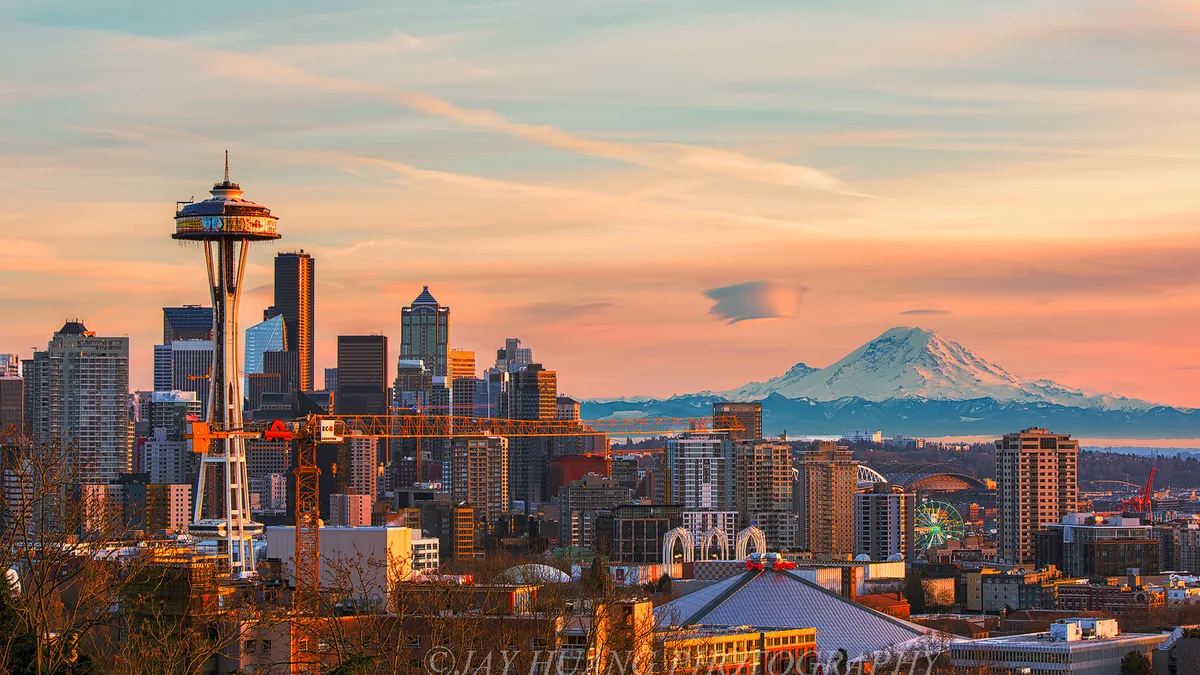UPDATE: Sept. 30, 2020: The Seattle City Council unanimously approved on Tuesday night a minimum wage for ride-hailing drivers of $16.39 per hour, that will go into effect on Jan. 1, 2021.
With the vote, Seattle became the second U.S. city behind New York City to institute a minimum wage for those who drive for Uber and Lyft. Under the legislation, drivers will be paid at least $0.56 per minute and $1.33 per mile driven while transporting passengers.
"Despite the economic challenges our City faces right now, Seattle will continue to be a national leader in ensuring our workers are treated fairly. The pandemic has exposed the fault lines in our systems of worker protections, leaving many front line workers like gig workers without a safety net," Mayor Jenny Durkan said in a statement after the bill’s passage.
Dive Brief:
- Seattle Mayor Jenny Durkan last week unveiled legislation she said would guarantee ride-hailing drivers are paid at least the city's minimum wage plus reasonable expenses. Durkan said she intends to transmit the legislation to the Seattle City Council this week.
- A study by James Parrott of The New School and Michael Reich of the University of California, Berkeley found that ride-hailing drivers in Seattle make $9.73 an hour after expenses, which is below the city's minimum wage for large ($16.39 an hour) and small ($15.75 or $13.50 an hour depending on tips and benefits) employers. Using that study, Durkan said Seattle will mandate drivers be paid at least 56 cents a minute plus compensation for reasonable expenses.
- The plan builds on Durkan’s "Fare Share" plan for ride-hailing drivers, which passed unanimously last year and pledged to study a reasonable minimum wage and compensation for benefits and expenses. "It is more important than ever that we pay drivers a fair wage and strengthen the economic resilience of our community of drivers," Durkan said in a statement.
Dive Insight:
Pushback from ride-hailing giants Uber and Lyft has been strong, with the former noting the similarities between Durkan's proposal and the ride-hailing regulations passed in New York City in 2018. Lyft, meanwhile, called the plan "misguided."
"A nearly identical law in New York City led to massive driver protests and fewer transportation options in low-income communities in just the first year of its implementation,” Uber spokesperson Harry Hartfield said in an email. "While we support the Mayor's efforts to improve earnings for drivers, copying a New York City policy that resulted in a 20% price increase for riders and lost earnings opportunities for thousands of drivers will not help achieve our shared goals in Seattle."
"The mayor's plan is unworkable," a Lyft spokesperson said in an email. "It would require [Transportation Network Companies (TNCs)] to double pay drivers who are using multiple rideshare or delivery platforms at the same time, as well as pay people to simply have an app open, even if they are not working. This kind of misguided regulation will actually destroy jobs for thousands of people and drive rideshare companies out of Seattle. Lyft has been clear that it supports smart benefits for drivers without taking away their independence or kicking people off the platform."
Both companies also pointed to what they said were significant flaws in the Parrott and Reich study, which surveyed self-selecting drivers and includes costs that the companies say are optional like supplemental insurance beyond what is required. Parrott and Reich's work was also cited by New York City when it drafted and approved its ride-hailing regulations. Uber and Lyft said riders have seen fares increase as a result, while the companies have been forced to restrict drivers' access to the apps.
Instead, Uber and Lyft said a study out of Cornell University is more reflective of the reality on the ground. That study, from Cornell's Industrial Labor Relations School, was based on wage data from the companies themselves and found that drivers in Seattle already have median hourly earnings of $23.25 after expenses. The same study also found that 96% of drivers work less than 40 hours per week. In response to that study being released and the subsequent criticism of their work, Parrott and Reich released a joint statement saying theirs is a more "comprehensive anaylsis" that does more to understand why drivers drive for the companies and why their pay is so low.
Ride-hailing's relationships with local government appears to be becoming more fractious in recent times as questions swirl about the industry’s future. A judge in California ruled Uber and Lyft must reclassify their drivers in the state as employees under a temporary injunction after the state sued saying the companies are in violation of the AB5 law that assumes workers are employees rather than independent contractors. Uber and Lyft threatened to pull out of the state in response.
Seattle's own outreach to almost 11,000 drivers found that the majority want higher pay and compensation, with many saying that is their highest priority. Any minimum wage would go into effect on Jan. 1, 2021. Plans for a minimum wage for ride-hailing drivers has also been floated in Los Angeles.












